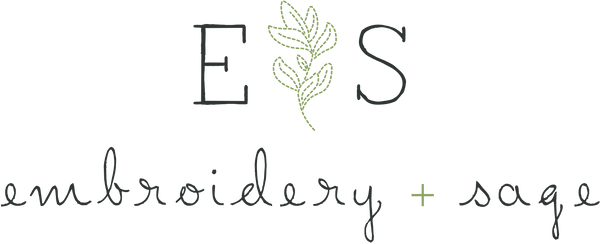to trace, or not to trace
In this tutorial we dive into our favorite ways on how-to-transfer a PDF embroidery pattern, using various techniques and water soluble magic. Deciding which method to use depends on the weight and color of your chosen fabric, and the complexity of the pattern. Let's have a look...
To Tracing...
If you have a simple design, the easiest way to transfer your pattern is by tracing. Below are two options for tracing - the method of choice is dependent on the weight and color of your fabric.
1. Trace with a water soluble pen.
This method is perfect for simple patterns, light weight and light colored fabrics.
- Tape the pattern to a light box, or window (if you don't have a light box).
- Tape the fabric over the pattern. The pattern should clearly be visible through the fabric for tracing.
- Trace the pattern.
- When finished stitching; wash the pen ink out with cold water and hang to air dry. Keep the fabric taut as you rinse and dry to prevent any wrinkles.
2. Transfer with carbon paper.
This method is perfect for simple patterns, heavy weight and/or dark colored fabrics.
- Lay the fabric face-up on a hard surface, such as a desktop or kitchen counter.
- Lay the carbon paper over the fabric with the waxy ink facing the fabric.
- Lastly, place the pattern on top of the fabric and carbon paper.
- With all three layers in place, trace the pattern using a pencil, stylus or empty ball-point marking pen. Be sure to press hard enough so that wax from the carbon paper marks the fabric.
*Be careful when tracing. The waxy ink usually does not wash out of most fabrics. Clean your needle after stitching as well, to get rid of any residue from the waxy ink.
To Not Tracing...
Some designs (such as our Paris or Amsterdam embroidery patterns) are too complex to trace by hand. Don't fret - we have a few tricks up our sleeves on ways to transfer the most intricate patterns. Below are two options - the method of choice (again) is dependent on the weight and color of your fabric.
3. Iron fabric to freezer paper and print.
This method is perfect for complex/intricate patterns, light weight and light colored fabrics.
- Purchase pre-cut freezer paper sheets, or cut your own (fit to size of your printer feed).
- Cut the fabric a little larger than the freezer paper and iron the wrong side of the fabric to the glossy side of the freezer paper. TURN STEAM OFF! The paper won't stick to the fabric if your iron is using steam. Iron till there is a solid bond between the fabric and paper (be careful not to burn your fabric).
- Trim fabric along the sides of the freezer paper - this step ensures you have clean cut edges for the printer. Give this one more iron to make sure the bond is secure between the materials.
- Run the "fabric paper" through the printer (image prints on the fabric). Help guide the "fabric paper" into the printer to make sure the printer feed grabs hold.
- Once your image is printed, peel off the freezer paper, and voila! You have a perfectly printed pattern ready to stitch!
*Sometimes the "fabric paper" will jam in the printer, and no amount of crossing your fingers and encouragement to your printer will stop this from happening. It may take a few tries before it prints out correctly (so make sure to have a little extra fabric and freezer paper to work with).
4. Transfer with water soluble paper.
This method is perfect for complex and simple patterns, light-medium weight and/or dark colored fabrics.
- Simply print your design out on the SULKY Water Soluble Paper, peel and stick to your fabric, and stitch.
- When finished stitching; wash the water soluble paper out with tepid water and hang to air dry. Keep the fabric taut as you rinse and dry to prevent any wrinkles.
*This method is probably the easiest way to transfer a pattern. However, your needle is going to get sticky while sewing. Be sure to have something on hand to clean your needle while stitching. A little eucalyptus spray can come in handy for this, plus it will add a calming aroma to your crafting space.



